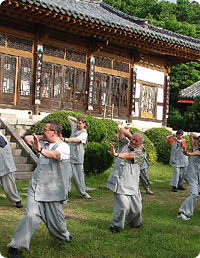SPECIAL INTEREST
Soft Adventure 9 days
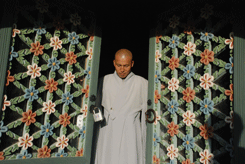
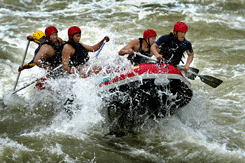
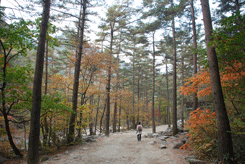
Tour Highlights
- Gyeongbokgung Palace
- National Folk Museum of Korea
- Insadong
- Namdaemun Market
- Cycling
- Hahoemaeul Village
- Andong Folk Museum
- Dosanseowon Confucian Academy
- Taebaek Coal Museum
- Woljeongsa temple stay
- Seoraksan National Park
- Unification Observatory
- DMZ Museum
Tour from April through October |
| Tour facts and features | |
| Accommodation | 8 hotel nights in 2 and 4 star twin share accommodation |
| Meals | 8 breakfasts |
| Transport | All transportation by private vehicle |
| Guided | Services of an English speaking guide |
| Group size | Maximum 9 |
| Age range | 18+ |
| Degrees of difficulty | Normal |
Note Bikeways are well established in areas, but much of roads are sharing with pedestrians, bicyclists and motorists. You need to understand how to safely and courteously share the road Bicyclists need to be aware of their surroundings. Watch for opening car doors, sewer grating, debris on the roads, uneven surfaces, and poorly lit tunnels |
Click on the days to access the programs quick
| Days | Visits and Activities | Distance |
| Day 1 | Arrive Seoul | 60km |
| Day 2 | Seoul | |
| Day 3 | Seoul - Paldang - Yeoju - Chungju - Suanbo | 170km |
| Day 4 | Suanbo - Hahoe - Andong | 130km |
| Day 5 | Andong - Dosan - Taebaek - Woljeongsa | 220km |
| Day 6 | Woljeongsa - Unduryeong - Hangyeryeong - Yangyang - Seoraksan | 160km |
| Day 7 | Seoraksan | |
| Day 8 | Seoraksan - Goseong - Seoul | 310km |
| Day 9 | Departure | 60km |
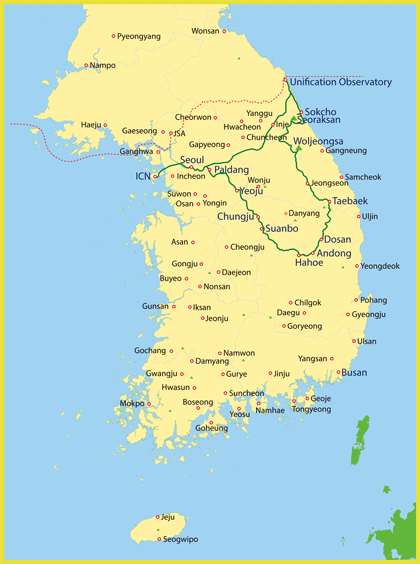 Day 1 Arrive Seoul (- - -)
Day 1 Arrive Seoul (- - -)
60km
Touching down at Incheon International Airport places you in the heart of Korea. After you clear Passport and Customs control, you will be welcomed by the tour guide and then transferred to your hotel.
Day 2 Seoul (B)
Your exploration this morning begins with a driving tour of Seoul, featuring sites such as Seoul Plaza, City Hall, Cheonggye Square and pedestrian-friendly Gwanghwamun Plaza that is hemmed in on both sides by rushing traffic and office buildings. The plaza is lined on each side with 365m long streamlets, two centimeters deep and one meter across, the stone bed of the plaza's east side waterway engraved with important events in chronological order from 1392 to 2008.
Step back in time to when life was gracefully slow and discover Gyeongbokgung Palace, a particularly charming spot that represents a colorful and turbulent side of the capital's 500-year history. Depending on timing, you may witness the Royal Guard Changing Ceremony featuring parade, password verification, duty shift and patrolling the gate. Accompanied by a court band with its colorful costumes and royal flags, the ceremony is performed daily basis at 10:00 and 14:00 except Tuesdays, although it is cancelled in case of rain or extremely hot or cold weather.
Your visit to the National Folk Museum of Korea will familiarize you with wealthy culture of this friendly and picturesque nation. It is an excellent facility to illustrate the history of traditional life of the Korean people from the prehistoric age to the Joseon dynasty. The permanent exhibition features life and work, costumes and ornaments, handicrafts and technology, educations, living quarters, dietary life, oriental medicine, performing arts and games, beliefs and rituals, and
socio cultural life.
Insadong, at one time the center of traditional Korean art and antiques, features a mixture of historical and modern atmosphere representing the cultural glimpse of the nation. Clustered along the main street and alleys are lined with street vendors, wooden tea houses, restaurants and numerous galleries and shops dealing in antiques, oriental art supplies, and modern Korean art of all types and styles. Soak in the paintings, upscale artworks, antiques and potteries while you can. Get lucky and you just might meet the artist themselves. It can be plenty of fun walking on the main street, but you venture into the hidden alleys that do spring some unexpected surprises. While here, you may want to buy some souvenirs or simply wander and browse at leisure admiring cultural ambience.
You will tour the centuries-old Namdaemun Market brimming with well over 11,000 shops selling anything you can imagine. One of the most colorful aspects of the market is an endless sprawl of street-vendor stalls that setup in the alleys and walkways between the buildings. The market is seriously crowded, so be prepared to get bumped around. A fantastic place to haggle over the price to get the best deal on something you want or simply admire the vibrancy of this massive market.
At the western entrance of the market in the middle of a traffic circle stands Sungnyemun. It is a formidable and iconic construct that served as the southern gate of the wall that surrounded Seoul during the period of the Joseon Dynasty.
Day 3 Seoul - Ungilsan - Yeoju - Chungju - Suanbo (B) 170km
The word of day is 7 hours riding of 105km. The Four Rivers Cross Country Cycling Road (also known as the 4 Rivers Bike Path or Trail) goes where the rivers go, be it through green forest or urban cement. The most famous challenge is the cross-country haul from Incheon to Busan: 633 kilometres of dedicated bike trail cutting through the mountainous interior to the south-east coast. Today, you will take a part of it from Ungilsan station to Chungju. You will not be alone on this ride. The cycleway is used by many local cyclist and people from other countries.
You are transferred to Ungilsan station to avoid heavy traffic and frustration in navigating the way onto the riverside bikepath. Get your bike at the station and begin your adventure to Chungju Jungangtap Park in the middle of which stands the 8th century Seven-Story Stone Pagoda. The trails are not for professional races or intense competition. More suited for relaxed biking than racing. The bike paths are relatively flat, which rarely or never enter car roads. Paths are paved and generally well maintained, and suitable for most people who have basic biking skills. The routes are mostly level but in some areas the routes travel through hilly terrain. Although the steeper sections are on roads, traffic is very light.
About 30km southeast of Chungju is Suanbo. This small town is renowned for its hot springs that originate deep beneath the earth and have an average temperature 53°C. Alkaline in nature, it contains such minerals as calcium, fluoride, lithium, sodium, and magnesium and is supposed to be good for your health. Soaking in the hot spa upon check in.
Day 4 Suanbo - Hahoe - Andong (B) 130km
You will explore UNESCO World Heritage Site, Hahoemaeul from the 15th century. It is the best preserved traditional village portraying and spanning the life of the Joseon Dynasty (1392-1910) and some 480 Korean traditional houses, both large and small, are still fully functioning. As you take a walk in the narrow alleys, enjoy the rustic and old charm of this unique village. You cannot possibly miss a 600-years old zelkova tree, the home to the village spirit. At the tree's base is where residents still make their wishes. The village is also known for traditional festival, Hahoe Mask Dance which gave common people the opportunity to mock those in authority, and in particular the Byeolsingut, a shaman ritual exorcising evil spirits, dating back to the Goryeo dynasty (918-1392).
Visit Jebiwon Buddha or Ichon-dong Stone Buddha. The awe-inspiring Buddha statue stands guard over the northern entrance way to Andong for nearly 1000 years. It's a relief-carving of the body on a sheer boulder-side, under a 3D-carved head made from a natural stone found on top of that cliff.
Tour also includes Andong Folk Museum offering in-depth information of traditional life and illustrating traditional Confucian culture. The museum exhibits a variety of legacies relating mainly to four cardinal ceremonies, coming of an age, wedding, funeral, ancestral memorial service, as well as dozens of pieces of pottery, utensils, clothing, farming tools and traditional folk games in small models.
Day 5 Andong - Dosan - Taebaek - Woljeongsa (B) 220km
The day is a bit heavy with more visits and temple stay program. Dosan Seowon is a Confucian-shrine academy which was established in 1574 in memory of Yi Hwang (1501-1570) who introduced Neo-Confucianism into Korea. The facility is composed of 16 buildings most of which were built in a simple and concise style. About hundreds of Seowon were functioning by the early 1800s, but then most of them were destroyed around 1870 by the ourt order. Dosan Seowon is among some of the few survived academies. Although the educational function of the facility has long since ceased, but you can feel Confucian ideology and value that has deeply influenced the lives of Koreans in all aspects.
Stop at Taebaek coal museum.Taebaek is a highland town once boomed with coal mining until the early 1980s. The museum showcases Korea's coal mining with well over 8,000 items including rocks such as silver, ore, fossils, and mining equipments and documents. You will also explore a mine simulation modeled closely after real mine showing how the mining work was like.
Taebaek boasts of two river sources. Hwangji pond from which 5,000 tons of water flows daily is the source of the Nakdong River and Geomryongso is that of Han River. The pond is a joint of underground water flow through the valleys of the mountains surrounding Taebaek and you will have time to see Hwangji pond.
Temple Stay is planned.
There are many temples in Korea, but the opportunity to observe and experience the ascetic Buddhist life in a temple does not come easily to outsider visitors. Some of the temples in Korea open their doors to foreign visitors for a short sojourn to give visitors the opportunity to see how monks practice their daily discipline from early morning prayers to evening rites. The temples are places where Buddha dwells and where the disciples of Buddha, or monks, practice asceticism. It is also a place where believers learn Buddhist teachings and put them into practice. Visitors will get to study and experience the Korean tradition and culture, all at the same time enjoying the nature.
Woljeonsa is an active Buddhist temple dating back to the 7th century providing a glimpse into Buddhist culture, breaking down the barriers of natioality and language to achieve communication and murual understanding among all humankinds. The program will comfort your weary soul and reflect on the busy path you have walked so far. A stay at the temple is spiritually healing, as it is with the sheer beauty of Odaesan mountain.
Temple stay program may slightly vary due to season and conditions of the individual temple situation but it basically goes as follow.
14:30 - 15:00 Arrival at the temple and Check in
15:30 - 16:50 Temple etiquette orientation and temple tour
17:00 - 17:30 Dinner in the temple dining hall - Vegetarian meal
18:05 - 18:20 Experience Bell Striking Ceremony
18:20 - 19:00 Evening Ceremonial Service - Yebul
19:00 - 20:00 Prayer Bead Making
20:00 - 21:00 Meditation
21:00 Bedtime
Upon arrival at the temple and having your rooms assigned with changing temple stay gown, you will have a temple stay orientation session during which desirable appearance, behavior in the temple and general manners in the Buddha Hall are briefed.
The food doesn't have spices and is neither hot nor salty - absolutely vegetarian meal. It is another mysterious experience for the commoners to try. You will wash your dishes yourself after meal.
Four Buddhist Instrument
Ceremony is performed at the bell tower. The bell, which almost all Korean temples are equipped with, is one of the four Dharma instruments together with Dharma drum, wooden fish, and cloud-shaped gong. Hearing it reverberating through the universe, you will reflect upon the profound symbolism of the instruments. It is a great vow to save, or enlighten the creatures in the universe including those on land, in the sea, in the air and in hell. You will have a chance to strike the bell with a help of monk.
You will then participate Evening Ceremonial Service - Yebul in the main Buddha hall.
The Yebul pays respect to Sakyamuni Buddha and all his disciples. It also provides a chance for self-reflection. During the Yebul, one ponders the Buddha's teaching and his life. Buddhists vow to practice diligently in front of the Buddha. Chanting is done for the Three Jewel, the Buddha, Dharma (his teaching) and Sangha (the community of sunims and lay Buddhists) and to assist all saints attain enlightenment.
Prayer beads are used by members of various religious traditions such as Hinduism, Buddhism, Christianity or Islam to mark the repetitions of prayers, chants or devotions, such as the rosary of the Blessed Virgin Mary in Catholicism.
You will also experience meditation, which is a work for enlightening yourself. You sit cross-legged on the floor. You embrace spirits and take away earthly thoughts and worldly desires. The word Seon originates from Sanskrit word Dhyana, which means contemplation, religious meditation, and intuition. It was originally translated Seonna. But was later shortened to Seon. Dhyana was the method of meditation in India which Sakyamuni Buddha used to attained enlightenment. Chamseon means entering into concentration. A prayer or chanting is easy to practice because it has an external form, but Chamseon has an internal direction only. That is, the principle characteristic of Chamseon is that there is no outward form, but there is simply an inward illumination. First, you sit in lotus position but with both feet pulled upwards on top of your thighs. Then, you put your palms down one on top of the other and made a circle with your thumbs, channeling the energy of the universe to the hottest part of your body by your belly button. The sound of Jugbi, or a bamboo clapper, gave the signal for the start of meditation. Then in a second, the hall is enclosed in complete silence. Neither sound nor motion could be perceived. It is another mysterious experience for the commoners to try.
All lights are turned off at 21:00. Apart from the moan of the wind, a quiet stillness prevails. The warm Ondol floors (heated from below) of the temple are clean and large enough to accommodate a small group of visitors. Rooms are sparsely furnished with mattress, quilt and pillow. It is advisable to bring your towel. However, the slight inconvenience is more than compensated by the tranquil and introspective atmosphere of the temple.
Day 6 Woljeongsa - Unduryeong - Hangyeryeong - Yangyang - Seoraksan (B) 160km
03:50 - 04:00 Wake up and washing
04:20 - 05:00 Pre-dawn Ceremonial Service - Yebul
05:00 - 06:00 Meditation
06:30 - 07:00 Breakfast
07:30 - 08:30 Morning walk
09:00 - 10:00 Tea time with monk
10:00 - 11:00 Writing comments
11:00 - 11:30
Lunch and check out
The day in the temple begins early when the sound of the moktak awakens the residents. Every monk and people in the temple will gather at the Main Buddha Hall and perform Pre-dawn Yebul. This magnificent Ceremony will clear all dust from your minds and all stray thoughts from your heads. And align your body in a proper way to have a release and cleanse your mind of earthly attachments, passions and delusion that disturb and pollute your body and mind.
Morning walk is voluntarily. From the main gate there is a 1.2 km forest trail that loops around the small river next to the temple that makes a very nice morning walk.
You may leave your comments on your experience in the temple, and tidy your room up.
Lunch is planned in the temple.
With time for a short stop at Unduryeong pass, drive the beautiful Misan Valley where clear water runs along for about 57km, admiring the pure look of upstream of Naerincheon. The view shows unpolluted, clean, and blue water ruffling through the rocks. You will also see the lonesome rural villages with their small swath of farms. In addition, mushrooms, honey bees, the sap from Acer mono trees and wild vegetables are some of the regions's specialties. Drive continues on Hangyeryeong pass down to Yangyang. Your journey is such a stark contrast from remote valley to the city. Spend the afternoon at the Naksan beach.
A short drive from the beach is Seoraksan national park.
Seoraksan features rugged peaks, fantastic cliffs, numerous waterfalls, unique rock formations, and scenic valleys altogether make this park and surrounding area some of the best scenery on the Korean peninsula, and give this area an unparalleled popularity around the year. The spring brings full of blooms and the summer creates lush green vegetation and crystal clear streams tumble over the cataracts. Fall changes foliage into brilliant colors and even in the winter, the snow blankets the hushed landscape, bringing serenity and a quiet beauty. You can definitely find lots of outdoor activities to make it worth while for an extended stay.
Day 7 Seoraksan (B)
The word of the day is hiking of varying lengths and difficulty. Only a small walk from the park entrance, you will marvel at a large bronze statues, Unification Buddha, symbolizing Korean people's hope for reunification of the country. A little further on is Sinheungsa temple where Cheonbuldong valley and Ulsanbawi trails begin.
Cheonbuldong valley Trail
It is the most impressive valley in the park, leading to Biseondae, Yangpok waterfalls and finally the peak of Seoraksan (1,708m). One hears many legends of the heavenly nymphs who come down to play at Biseondae while taking a bathe in the placid pools of the valleys that are hidden from the human eyes. Near Biseondae rises Janggunbong majestically and among the crags of it is Geumgang cave with a tiny temple inside. You will head up a very steep incline for 600m from the gentle slope of the trail, and you can scale only by carefully ascending the long, steep, metal stairs bolted onto the sheer cliff face. The hike, although hard, comes with a stunning view of numerous cliffy peaks and mountain valley. From Biseondae, another 3.5km to Yangpok Falls, so spacious yet everywhere you looked you are surrounded by giant mountain peaks.
Ulsanbawi Trail
About an hour and half into the walk from the park entrance is Gyejoam hermitage. Located at the base of Ulsanbawi, and the point at which the trail takes a sharp rise upwards. In front of the hermitage on a spacious stone slab is a huge spherical rock called Heundeulbawi. This rock is so perfectly balanced that it can be shaken with some effort, but nobody gets further than waggling it. Your adventure begins by climbing a massive steep staircase that winds its way up the side of the cliff that angle up Ulsanbawi, a 2.8km-long ridge of naked, gray stone peaks jutting 873m into the sky.
Biryong waterfall Trail
The trail is relatively easy for anyone to enjoy and you will view Biryeong waterfalls at the trail end. About 400m further above the falls, you will be amazed at Towangseong waterfalls cascading down a 320-meter cliff.
Cable Car
There is a cable car that picks you up at the valley floor to the Gwongeumseong. The peak is surrounded by cavernous drop-off cliffs, cloaked in more towering rocky summits. Definitely, you stand in awe on the top: sweeping panoramic views of the park around you, the Pacific Ocean, and the small beachside town of Sokcho. Be careful as always as there is not much room to move about and people constantly going up and down and moving around.
Among the recommendable trails from Sogongwon or park entrance (230m above sea level) are as follow and the given times are based on round trip starting and ending at Sogongwon in a relaxed pace.
1. Biryong Falls (310m) + Towangseong Falls observatory (5.6km): 3 hours 30 minutes
- Moderate and Strenuous
2. Biseondae (334m) (6km): 2 hours 30 minutes - Moderate
3. Biseondae + Geumgang cave (495m) (7.2km): 4 hours - Moderate and Strenuous
4. Biseondae + Yangpok (715m) (13.2km): 7 hours - Moderate
5. Heundeulbawi (510m) (6.6km): 3 hours - Moderate
6. Heundeulbawi + Ulsanbawi (873m) (7.6km): 5 hours 30 minutes - Moderate and Strenuous
7. Gwongeumseong (800m) Cable car (3.4km): 1 hour (roughly four minutes each up and down)
- Moderate
Sokcho has so much more to offer than just mountains. Daepohang becomes a great attraction when this small alley lit up. You will see a wide variety of fresh seafood harvested from the nearby sea and a number of small restaurants serving sliced raw fish. You will find something to enjoy, from simply feeling the ambiance of this small fishing port to taking picture. And in downtown, there is a colorful market selling fishes, fruits, vegetables, grains and daily necessities, and a little further down is a North Korean refugee village that can be accessible by a hand-pulled boat.
Day 8 Seoraksan - Goseong - Seoul (B) 310km
Then, travel to the most northern tip of the east coast. Less convenient to get to, the route offers much more pleasant countryside scenery and remote tranquility. Unification Observatory was established in 1983 to console pains of division, nostalgia and inscribe unification will. With the entry permit and sign to place in the vehicle window ready, you continue towards the north, driving past lots of tank traps sat on either side of the road, all a strange and eerie reminder of the tensions that exist between the two Koreas and the stark reality of the divided country. The big blocks are designed to topple onto the road and create a road block to prevent an advance of the North's tanks and artillery vehicles into the South. Once there, you will get a glimpse of the much talked about border dividing the two Koreas and see the road and train track stretched side by side ahead across the North Korea, and soldiers patrolling the beach as well as some nearby islands.
Visit DMZ Museum (Closed on Mondays) offering a surreal experience. In a hope of bringing peace to the country from the painful past, the museum presents a South Korean side of conflict with the North, understanding the historical significance of the DMZ and embracing everything about the latest efforts made to transform the DMZ from a political scars to a symbol of peace and ecology.
Day 9 Departure (B) 60km
After this wonderful trip exploring Korea and with time to reflect on your surprise in your experience, you will return to the airport in time for your flight. By boarding, you are already high above Incheon heading for home.





